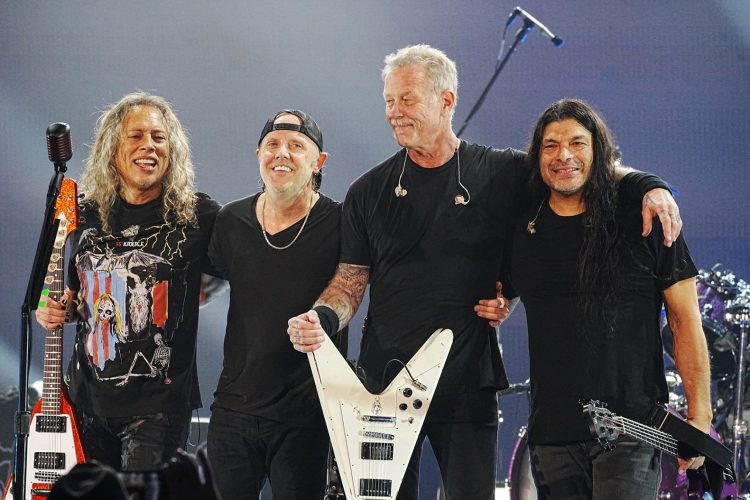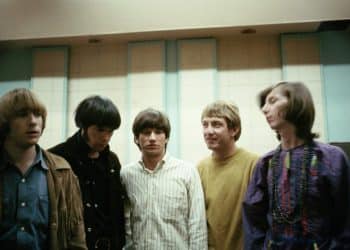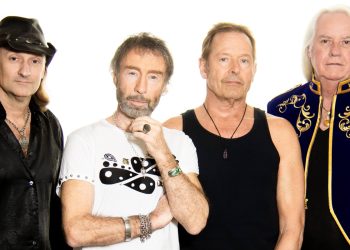Few bands in the history of music have left as indelible a mark as Metallica. With their thunderous riffs, electrifying solos, and deeply emotional lyrics, this legendary band has defined the sound of heavy metal for over four decades. From the raw aggression of their early thrash-metal days to the polished anthems of their later years, Metallica’s music has transcended generations, earning them a fiercely loyal fanbase and a place in the pantheon of rock gods.
But what are the songs that truly stand out? The ones that defined their career, electrified arenas, and became anthems for millions worldwide? In this article, we’re diving headfirst into the ultimate Metallica playlist: the top 10 most popular songs of all time. Whether you’re a die-hard fan who’s headbanged to every album or a curious newcomer looking to experience the best of the band, this list will take you on a thrilling ride through Metallica’s greatest hits.
From iconic tracks like “Enter Sandman” to the heart-wrenching “Nothing Else Matters,” each song on this list showcases Metallica’s unparalleled ability to blend raw power with emotion. Get ready to crank up the volume and immerse yourself in the thunderous world of Metallica!
1. Enter Sandman (1991)
Released as the lead single from Metallica (often referred to as “The Black Album”), Enter Sandman is a colossal force in heavy metal history. The song’s eerie, creeping intro gradually builds tension before exploding into one of the most recognizable riffs of all time. From the very first note, it grips the listener, pulling them into a world of childhood fears and nightmares. Lyrically, the song taps into universal anxieties—fearing the dark, the unknown, and the lurking shadows of the subconscious. James Hetfield’s commanding vocals, paired with Lars Ulrich’s pounding drums, create a relentless momentum that makes the track feel both ominous and exhilarating. The chorus, with its simple yet unforgettable hook, is designed for stadium-sized singalongs, and it quickly became a defining anthem of the ‘90s rock scene. Beyond its success on the charts, Enter Sandman played a crucial role in bringing Metallica into the mainstream, introducing countless new fans to the band’s raw power. Its energy, massive production, and dark themes made it an instant classic, and to this day, it remains a staple of their live performances, often serving as the grand finale to their electrifying shows.
2. Master of Puppets (1986)
Few songs in metal history are as revered as Master of Puppets, the title track from Metallica’s third studio album. This eight-minute epic is a masterclass in thrash metal, blending breakneck riffs with complex, thought-provoking lyrics. The song kicks off with an aggressive, chugging guitar riff that immediately sets the tone for what’s to come—a relentless journey through the dark realities of addiction and control. Hetfield’s lyrics paint a vivid picture of a person manipulated by a force stronger than themselves, whether it be drugs, power, or society itself. The track’s structure is dynamic, shifting from intense, high-speed riffing to a hauntingly melodic midsection that provides a brief moment of respite before the chaos returns. Kirk Hammett’s guitar solo is nothing short of legendary, weaving emotion and technical prowess into a moment that defines the song’s intensity. Master of Puppets is widely considered one of the greatest heavy metal songs of all time, a staple at Metallica concerts, and a testament to the band’s ability to blend raw aggression with deep musicality. Decades later, its impact remains just as powerful, influencing generations of musicians and fans alike.
3. Nothing Else Matters (1991)
A significant departure from Metallica’s usual thrash-metal ferocity, Nothing Else Matters showcases a different side of the band—one that’s introspective, emotional, and deeply personal. Written by James Hetfield as an intimate reflection on love and distance, the song’s delicate acoustic guitar intro immediately sets it apart from the rest of The Black Album. The lyrics convey a vulnerability that was unexpected from a band known for their aggressive sound, making this track an instant standout. The orchestral backing adds another layer of depth, elevating it into an arena-filling ballad that transcended the metal genre. While some early fans viewed it as a risky move, Nothing Else Matters quickly became one of Metallica’s most beloved and commercially successful songs, proving that even the heaviest bands can have a softer side. Its universal message of devotion and emotional honesty has resonated with listeners for decades, making it a favorite at weddings, concerts, and even mainstream radio. The song’s beauty lies in its simplicity, yet its raw emotion continues to captivate audiences, solidifying its place as one of the most iconic ballads in rock history.
4. Fade to Black (1984)
From the moment the opening acoustic melody begins, Fade to Black sets an emotionally heavy tone, unlike anything Metallica had released before. Featured on Ride the Lightning, this track is a powerful exploration of despair, loss, and inner turmoil. The lyrics reflect deep existential pain, resonating with listeners who have faced moments of darkness. As the song progresses, the intensity builds—what begins as a soft lament transforms into an electrifying crescendo of distorted guitars and soaring solos. Kirk Hammett’s closing solo is particularly haunting, carrying the listener through a wave of emotion that lingers long after the song ends. At the time of its release, Fade to Black was controversial among some metal purists, as it introduced a slower, more melodic style into Metallica’s repertoire. However, it ultimately became one of the band’s most celebrated songs, proving that heavy music could be just as powerful in its moments of sorrow as it is in its aggression. Today, Fade to Black is recognized as one of the most emotionally charged and impactful songs in the metal genre, a piece that has helped countless fans find solace in its honesty.
5. One (1988)
Arguably one of the most cinematic songs in Metallica’s discography, One is a haunting portrayal of war’s psychological and physical horrors. Inspired by the novel Johnny Got His Gun, the lyrics tell the story of a soldier trapped in a motionless body, unable to communicate or escape his own mind. Beginning with a somber, clean guitar melody, the song gradually intensifies, mimicking the slow realization of the protagonist’s fate. As the tension builds, Metallica delivers one of their most explosive finales—machine-gun-like double bass drumming, rapid-fire riffing, and a guitar solo that embodies pure desperation. The song’s impact was amplified by its groundbreaking music video, which intercut scenes from Johnny Got His Gun with the band’s intense performance. This marked Metallica’s first foray into music videos, helping to bring their music to a broader audience while staying true to their raw and uncompromising artistry. One remains a highlight of the band’s live shows, often accompanied by stunning pyrotechnics that add to its dramatic flair. The song is more than just a fan favorite—it’s a defining moment in metal history.
6. The Unforgiven (1991)
From The Black Album, The Unforgiven is one of Metallica’s most emotionally charged and introspective songs. Unlike their usual formula, the verses here are soft and brooding, with Hetfield’s sorrowful vocals taking center stage. The contrast between these somber verses and the explosive, anthemic chorus creates a dramatic push-and-pull effect, reflecting the inner conflict described in the lyrics. Thematically, The Unforgiven delves into themes of regret, self-judgment, and the struggle for personal redemption. The song’s orchestral horn intro adds a sense of grandeur, while Kirk Hammett’s blues-tinged solo injects soul into the composition. Though different from Metallica’s earlier thrash anthems, The Unforgiven became a massive success, resonating with fans on a deeply personal level. It was so influential that it later spawned two sequels, The Unforgiven II and The Unforgiven III, both continuing the themes of struggle and acceptance. Even after decades, the original remains the most powerful, standing as one of the band’s most haunting and timeless tracks.
7. Seek & Destroy (1983)
From the moment its opening riff kicks in, Seek & Destroy is an unmistakable call to arms for metal fans everywhere. One of the standout tracks from Metallica’s debut album, Kill ‘Em All, this song captures the raw, unfiltered energy of the band’s early thrash metal days. Inspired by the aggression and intensity of classic heavy metal bands like Motörhead and Judas Priest, Seek & Destroy boasts razor-sharp riffs and an infectious chorus that’s practically made for audience singalongs. Lyrically, the song taps into themes of rebellion and destruction, making it a perfect anthem for live performances—especially when James Hetfield famously encourages the crowd to shout, “Searching… Seek and Destroy!” Despite being one of Metallica’s earliest tracks, it remains a fan favorite, appearing frequently in their live setlists. Over the years, the song has evolved into an electrifying live experience, sometimes extended with added solos and crowd interactions. Seek & Destroy embodies everything that made early Metallica so thrilling—speed, aggression, and an undeniable sense of attitude that still makes it one of their most exhilarating songs to this day.
8. Battery (1986)
If there was ever a song that perfectly captured the essence of thrash metal, it’s Battery. Opening with a deceptively serene acoustic guitar passage, the track lulls the listener into a false sense of security before launching into a full-throttle assault of blistering riffs and relentless speed. Serving as the opening track for Master of Puppets, Battery immediately sets the tone for one of the greatest metal albums of all time. The song’s relentless energy is a testament to Metallica’s ability to craft complex, high-speed compositions while maintaining precision and tightness. Lyrically, Battery is an ode to the raw power of music, particularly the aggressive nature of thrash metal itself. It speaks to the sense of unity and strength found within heavy music, making it a rallying cry for metalheads around the world. As one of Metallica’s most aggressive and high-energy tracks, Battery continues to be a staple of their live performances, often inciting some of the wildest mosh pits at their concerts. Even decades after its release, the song remains a ferocious reminder of Metallica’s ability to push the limits of speed and intensity.
9. For Whom the Bell Tolls (1984)
With its thunderous opening bassline and apocalyptic atmosphere, For Whom the Bell Tolls stands as one of Metallica’s most powerful and enduring songs. Inspired by Ernest Hemingway’s novel of the same name, the track paints a vivid picture of the brutal realities of war, focusing on the senseless violence and tragic fate of soldiers caught in battle. Cliff Burton’s iconic, distorted bass intro immediately sets the tone, creating an ominous and almost cinematic feeling before the crushing guitars and pounding drums take over. The song’s mid-tempo groove gives it a weighty, marching feel, making it a standout in Metallica’s typically fast-paced catalog. Hetfield’s vocals are commanding and forceful, delivering lines that feel more like warnings than lyrics, adding to the song’s intensity. Unlike many of Metallica’s early thrash-heavy tracks, For Whom the Bell Tolls focuses more on atmosphere and storytelling, proving the band’s ability to craft epic, slow-burning anthems. It remains one of the most recognizable and beloved songs in their live repertoire, often accompanied by dramatic lighting and pyrotechnics to enhance its battlefield-like grandeur.
10. Sad But True (1991)
With a crushing, down-tuned riff that feels like an unstoppable force, Sad But True is one of Metallica’s heaviest and most menacing tracks. Featured on The Black Album, this song trades the band’s signature speed for sheer, bone-rattling weight. The main riff, driven by James Hetfield’s downpicked precision and Kirk Hammett’s deep, chugging tones, delivers a sense of overwhelming power, making it one of the most headbang-worthy songs in their catalog. Lyrically, Sad But True explores themes of control and manipulation, with Hetfield’s lyrics depicting a sinister presence that dominates and consumes its subject. The song’s groove-laden tempo and crushing rhythm give it an almost hypnotic quality, making it a standout among Metallica’s slower, more brooding tracks. Over the years, Sad But True has remained a staple in their live performances, often featuring extended riffs and audience participation. Its massive sound and ominous tone make it a unique entry in The Black Album, showcasing Metallica’s ability to create something just as impactful and aggressive at a slower tempo as they do at breakneck speed. It remains one of their most recognizable and powerful songs to this day.









